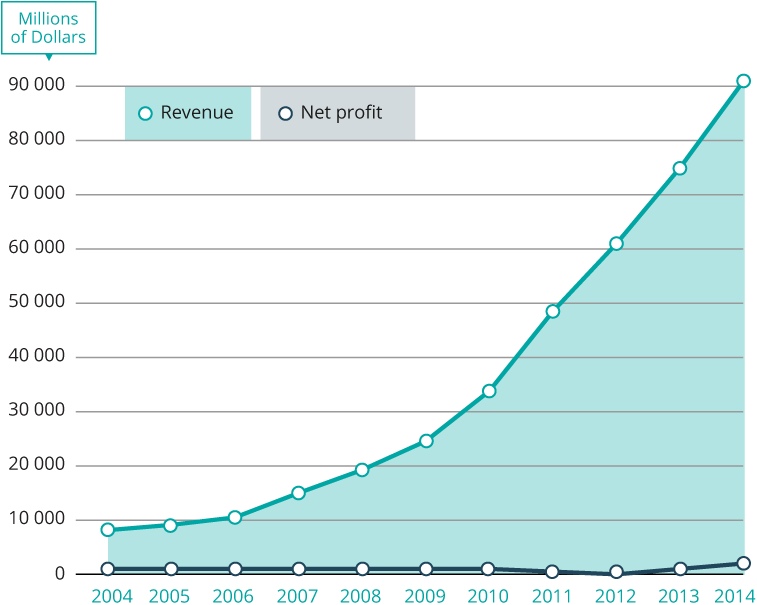What lessons
are to be
drawn from
Amazon?
Twenty years ago, in July 1994, Jeff Bezos launched what would become the biggest online electronics store in the world. To underline the 20th anniversary of Amazon, we are revealing the secrets of its success and a three ways to draw inspiration from them.
How does Amazon work?
Amazon’s success probably has more to do with its business model than the structure of its website. Believe it or not, it took seven years for Amazon to turn its first profits. If you think that after 20 years, the company is now generating astronomical profits, think again: in 2013, even with revenues in excess of $17 billion, Amazon has made practically no profit.
Why? Because the e-commerce giant invests almost all of its income in new activity sectors.
Amazon.com's revenue & profit 2004-2014

Note: 2013 and 2014 are estimates.
In economic terms, Amazon is more of an investor than a products and services supplier. Its enormous sales volume enables it to renew its inventory about every 20 days, whereas suppliers demand to be paid about every 45 days. Somewhat like a bank, Amazon grows money that it does not have, or that it must return at least.
By not focusing on classic profit margins, the e-commerce giant can offer prices that are much lower than the average, even if it does not make a profit on certain sales.
Did you know?
The arrow on Amazon's logo, which goes from the "A" to the "z" means that the company offers all products, from A to Z
Three lessons to draw from Amazon
Amazon’s success does not only come from its economic model. It also has a specific objective: facilitate the customer’s experience.
01
Perform user tests
Changes made to Amazon’s website are systematically tested with a limited number of users. Modifications are only officially integrated to the website after they have undergone A/B testing.Obviously, few companies that enter the e-commerce market have Amazon’s traffic or resources. But that does not prevent them from having the same objective!
Ask a few people who do not know your business or your website to perform a specific task (buy product X, request service Y, find the opening hours, etc.), and make a note of their smallest actions and hesitations, even if you have to film them. The purpose of this exercise is to analyze your website, not justify your choices.
You may then decide to modify a menu name, create an icon or move a tab. You could be surprised by the effects that these “details” could have on your conversion rate!
02
Create simple and appealing forms
At the beginning of 2000, one of the members of the Acomba e-commerce team was in charge of a company’s Web form. We were at the dawn of e-commerce, and the potential of this tool was sometimes questioned.
After analyzing the competition, our colleague noticed that many Internet users consulted Web forms, but they almost never made it to the end.
By changing the questions and performing user tests, he was able to reduce the abandonment rate from 80% (competition) to 20%, while the online sales objectives were exceeded by 400%!
Amazon’s developers also understood very early that to maximize the conversion rate, buyers would have to make as little effort as possible and gradually commit to the purchase process.
On Amazon, users who already have an account simply have to click the product they want to buy, select the quantity, click “Add to Cart”, then “Proceed to Checkout”, and the purchase process is done! Now there’s a standard to reach.
Did you know?
On June 18, 2014, Amazon launched its own smartphone, the Fire Phone.
03
Generate cross-selling
On Amazon, when you consult a product file, a series of other products appear in a section called “Customers Who Bought This Item Also Bought…” What a great way to generate additional sales! However, it’s hard to use this algorithm without a huge volume of traffic.
Smaller companies can still cross-sell by building on product category. Did the Internet user buy a yoga mat? Why not suggest an exercise ball? Did she buy inline skates? Suggest a helmet. He buys a game console? Suggest games, etc. You just need tools that, like Acomba e-commerce, make this operation possible.
Internet users may not purchase the suggested product immediately, since that is not the reason they went to your website. However, if they need the product one day, they will know that you sell it.
Did you know?
In 2014, Amazon.com received an average of 164 million visits per month, or about half of the population of the United States or almost five times the population of Canada.
Warning: you are not Amazon
Amazon’s business model and size are unique, which means that you should not systematically copy all of its functionalities.
For example, the possibility to leave comments may be attractive, especially when 74% of Internet users believe they need to read comments to judge a product. However, this could be a risky choice if you do not have a lot of traffic: having a single comment on a series of products could raise suspicions among consumers.
It might be a good idea to browse on Amazon to get ideas, but it is important that you not fill your website with useless functions.
Basically, the true secret of Amazon is human rather than technical: audacity. If you use your audacity to further your company’s mission while keeping your customer’s interests in mind, you increase your chances of attracting customers!
This article was originally published on August 11, 2014.

The Acomba blog is brimming with articles on business, IT and business management.
Subscribe so you don’t miss a thing!

I am already subscribed